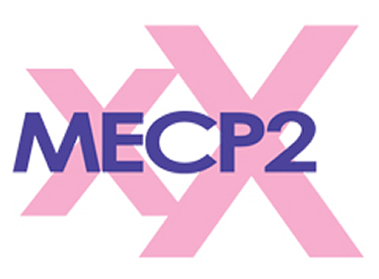Rett syndrome is a unique postnatal neurological disorder that is first recognized in infancy and seen almost exclusively in girls, but in very rare cases can be seen in boys. Rett syndrome is often misdiagnosed as autism, cerebral palsy, or non-specific developmental delay. Rett syndrome is caused by mutations on the X chromosome on a gene called MeCP2. There are more than 200 different mutations found on the MeCP2 gene and the majority of the mutations are found in eight different “hot spots”.
Rett syndrome was named after Dr. Andreas Rett, who first recognized and described this syndrome. A syndrome is a group of symptoms - when put together these symptoms identify a special condition or syndrome. Girls with Rett syndrome show similar symptoms which were grouped together by Dr. Rett as "Rett syndrome".
Rett syndrome occurs worldwide and affects 1 of every 10,000 female births. It strikes all racial and ethnic groups. It is a neurodevelopmental regressive disorder. Rett syndrome symptoms appear after an early period of apparently normal or near normal development until six to eighteen months of life, when there is a slowing down or stagnation of skills. A period of regression then follows when she loses communication skills and purposeful use of her hands. Soon, stereotyped hand movements such as hand washing or wringing movements, gait disturbances, and slowing of the normal rate of head growth become apparent.
• Girls with Rett syndrome have a small head size and it grows at a slow rate.
• They lose their ability to use their hands to pick up and hold objects
• They can no longer speak or have only few words.
• They show strange behaviors with poor social interaction.
• Their ability to learn is affected but they are able to understand simple instructions.
• They show distinctive repetitive movements of hands, including hand flapping, hands in mouth, teeth grinding, etc.
• They may breathe differently, either holding their breath called “apnea”, or breathe heavily (huff or puff) called “hyperventilation”.
• They may be irritable and may have trouble chewing, swallowing and with sleep.
• Their hands and feet are often cold and they may not show discomfort to hot or cold temperatures and pain.
• They may walk with stiff with legs wide apart
• They may experience frequent falls and have difficulty getting up or changing positions;
• They may develop curvature of the spine called “scoliosis” or “kyphosis”, which causes abnormal body posture, leaning to the side or forward.
• As they get older, they may stop walking and need to be carried.
Rett syndrome had been a clinical diagnosis until 1999 when mutations of the gene MeCP2, at Xq28, were identified in 95% of Rett syndrome patients and genetic confirmation became available.
Rett syndrome is confirmed with a simple blood test to identify the MeCP2 mutation. However, since the MeCP2 mutation is also seen in other disorders, the presence of the MeCP2 mutation in itself is not enough for the diagnosis of Rett syndrome. Diagnosis requires either the presence of the mutation (a molecular diagnosis) or fulfillment of the diagnostic criteria (a clinical diagnosis, based on signs and symptoms that you can observe) or both. The course and severity of Rett syndrome is determined by the location and type of the MeCP2 mutation and also the X chromosome inactivation phenomenon. Therefore, two girls of the same age with the same mutation can appear quite different.
Mutations in another gene on the X-chromosome known as CDKL5 (cyclin-dependent kinase-like 5) can cause an atypical form of Rett syndrome and generally tests negative for a MeCP2 mutation. Not everyone with a CDKL5 mutation appears as atypical Rett syndrome. For more information, visit www.cdkl5.com
Mutations on chromosome 14 on the gene FOXG1 can also be responsible for a congenital variant of Rett syndrome and generally test negative for a MeCP2mutation. Not everyone with a FOXG1 mutation appears as atypical Rett syndrome. For more information, visit foxg1.com
Mutations in another gene on the X-chromosome known as WDR45, which is known to be associated with BPAN syndrome, has recently been found in a few girls who have a clinical diagnosis of Rett syndrome and no positive MeCP2mutation.
| Requirements for Rett Syndrome diagnosis |
| Consider diagnosis when postnatal deceleration of head growth observed. |
| Required for typical or classic RTT |
Required for atypical or variant RTT |
• A period of regression followed by recovery or stabilization
• All main criteria and all exclusion criteria
• Supportive criteria are not required, although often present in typical RTT
|
• A period of regression followed by recovery or stabilization
• At least 2 of the 4 main criteria
• 5 out of 11 supportive criteria
|
| Criteria for Rett Syndrome diagnosis |
| Main Criteria |
• Partial or complete loss of acquired purposeful hand skills
• Partial or complete loss of acquired spoken language
• Gait abnormalities: Impaired (dyspraxic) or absence of ability
• Stereotypic hand movements such as hand wringing/squeezing, clapping/tapping, mouthing and washing/rubbing automatisms
|
|
| Exclusion criteria for typical RTT |
• Brain injury secondary to trauma (peri or postnatally), neurometabolic disease, or severe infection that causes neurological problems
• Grossly abnormal psychomotor development in first 6 months of life
|
|
| Supportive criteria for atypical RTT |
• Breathing disturbances when awake
• Bruxism when awake
• Impaired sleep pattern
• Abnormal muscle tone
• Peripheral vasomotor disturbances
• Scoliosis/kyphosis
|
• Growth retardation
• Small cold hands and feet
• Inappropriate laughing/screaming spells
• Diminished response to pain
• Intense eye communication - eye pointing
|
1. Rett syndrome affects one in every 10,000 female births.
2. It occurs worldwide and affects all races and ethnicities.
3. It is caused by a mutation of the MeCP2 gene located on the X chromosome.
4. Early developmental milestones appear normal, but between 6-18 months of age, there is a delay or regression in development, particularly affecting speech, hand function and walking.
5. Hall mark of Rett syndrome is repetitive hand movements characterized as “hand washing” or “hand wringing” movements.
6. Girls with Rett syndrome understand far more than they can communicate as evidenced by their bright and attentive eyes and their ability to express emotions.
7. Most children suffer from frequent seizures, irregular breathing patterns and muscle stiffness.
8. Girls with Rett syndrome require continuous supervision and maximum assistance.
9. Despite its mental handicaps, Rett syndrome is not a degenerative disease.
10. There is currently no cure. Most girls live long into adulthood.

Together, we can change lives. Partner with the Manitoba Rett Syndrome Association to help raise awareness and open the doors to treating Rett Syndrome and other neurological disorders.
1. Family Events
2. Rett Syndrome Awareness Month - OCTOBER
3. Fundraisers
The Canadian Rett syndrome registry is a national database for individuals diagnosed with Rett syndrome. The registry aims to enroll all living Canadian residents diagnosed with Rett syndrome. Unfortunately at this time the registry will not collect information on people with Rett syndrome who have passed away. The registry is a critical step that will organize the Canadian Rett syndrome population to attract more research opportunities to Canada with a special focus on clinical trials of potential new treatments.
Researchers studying Rett syndrome need good information to understand how the disease affects people. Scientists, who want to start research studies, including those testing new treatments, can use the registry to find people who are eligible to participate in these studies. This helps to reduce study costs and makes it easier for eligible participants to find these important studies. The registry will serve to improve the quality of life of people affected by Rett syndrome by enabling research into new and improved treatments and by promoting up-to-date and consistent care across Canada
There is no guarantee that your family will benefit from joining the Canadian Rett syndrome registry. However your participation may be important for the following reasons:
• It will help to increase information available to researchers about people with Rett syndrome
• It will help to increase the information available about how many Canadians are affected by Rett syndrome
• It will help to locate people in Canada affected by Rett syndrome who are interested in participating in research opportunities.
• Join the Registry Today!
By clicking the link http://www.rett.ca/registry/ you will access the Canadian Rett syndrome registry’s secure website where information for the registry is collected. Before you officially join the registry, detailed information about the registry will be provided for your review. After reviewing the information you will be asked to provide your consent to join the registry. Your participation is voluntary and you may choose to withdraw from the registry at any time.
